REPORT: Laura Misch X holobiont
- holobiont
- Apr 8, 2024
- 12 min read

Introduction
This report gives an overview of the work we did with the musician Laura Misch. We started looking at her music practice to identify ways to embed sustainability into her creative process and outcomes in early 2023. To acknowledge the kinds of value music – and cultural production more widely – can generate, we decided to push the boundaries of imagination beyond default conceptions of sustainability that only focus on ecological impact. Building on the ‘triple bottom line’ that includes eco-social indicators alongside financial profit, we defined four lenses to look through: social, ecological, cultural and economic value. This acknowledges the interdependence of socio-cultural and ecological factors, as well as the need for an economic foundation for the project to sustain itself. Over the course of the year, we collaborated in different formats to expand the world of Laura’s new album Sample The Sky, and tried putting these principles into action. The aim was never perfection, but to think and experiment expansively with what sustainability could look like in cultural production.

We set out for these lenses to include consideration of the following:
Social: Focus on accessibility (physical, psychological, financial); Engagement with the record through new, participatory formats
Ecological: Regenerative narratives; thematic exploration through artefacts and experiences; sustainable merchandise and record production
Cultural: Cultural artefacts and experiences beyond gigs and merch
Economic: Free and pay what you can events; low cost and free base materials for merch
Sustainability & Music – The Current Landscape
Beyond our belief in the radical potential inherent in music, we did a brief survey of initiatives and people addressing sustainability in the sector directly. These mini case studies of UK-based initiatives showed that there is already a lot happening in the cultural sector, which informed how we positioned our own work.
Julie’s Bicycle
Julie’s Bicycle is a ‘leading not-for-profit, mobilising the arts and culture to take action on the climate, nature and justice crisis.’ With the following objectives: Become net zero carbon and restore nature; Inspire public action on climate and ecology; Champion environmental justice and fairness; it is clear that they operate at a high level, focusing on systemic work that targets the movers and shakers in the music industry. They do this through the likes of leadership training, open access resources, consultancy and more. Their aim is to influence and change the industry itself. They cite an impressive reach and influence in the public and private sector.
EarthPercent
EarthPercent is a charity that ‘encourages artists and music-related organisations to pledge a small percentage of their income to EarthPercent. [...] It will be directed to the most impactful organisations dealing with climate change.’ A noble intention, and financially effective if big players get involved. But with a focus on philanthropy, this leaves responsibility to take climate action with fans (to purchase) and artists (to pledge), many of whom are smaller and already struggle financially in an extractive industry. This initiative may not change the DNA of the cultural sector itself, but is generating awareness and community amongst musicians.
Music Declares Emergency
Music Declares Emergency runs under the banner ‘no music on a dead planet’. It is ‘a group of artists, music industry professionals and organisations that stand together to declare a climate and ecological emergency and call for an immediate governmental response to protect all life on Earth.’ Their initiatives include: the No Music on a Dead Planet Campaign; a signable declaration that proclaims an ecological emergency; climate media training to help artists use their platform for advocacy; an info pack that gives practical advice on how artists can take action with venues, manufacturing, touring, and merch; and larger Earth Day initiatives.
Rally Festival
Rally markets itself as a values-led, one-day festival inspired by DIY culture. The website features a ‘values’ page, which cites ‘diversity, transparency and environmental sustainability’ as one of their focal points. However, from the website it isn’t clear how this ethos is put into practice. We would need to speak to the organisers to get a better understanding here.
Grass-roots and other initiatives
There are lots of examples of people taking action on a smaller scale in London’s creative ecosystem. To name a few: Climate Controlla organise parties to connect the intersectional causes of climate and migrant justice and bring politics to the dancefloor through a variety of formats; ClubSol cite solarpunk philosophy as inspiration for their multi-modal events; Misery Party is a sober party for BIPOC people and has expanded into foraging and other community focused events. Overall we found that smaller initiatives seemed more focused on collective liberation through intersectional and transformational approaches to the ecological and social challenges we are facing.
Insights
Our initial research showed that there are established and large-scale initiatives focusing on direct advocacy, practical advice, fundraising, and systemic and policy change. Overall, the framing of these initiatives, particularly in reference to environmental challenges, is one of ‘crisis’ and ‘emergency’. This negative framing makes sense in the face of urgency. But we felt there was a need for softer, more hopeful and regenerative narratives that people can relate to and experience on a personal level, which means our philosophy is aligned with liberatory grassroots initiatives. Led by the question: ‘What does it look like to see music and culture as a force to help regenerate the web of life that sustains us on this planet?’, we decided to focus on creative and experiential ways to address these themes through Laura’s practice. We saw an opportunity to expand into different forms of sustainability by focusing on the following:
Tastemaking: Giving sustainability a new image through events and merchandise by embedding it as a baseline – this goes beyond branding events and artefacts as ‘eco-friendly’ or ‘sustainable’ and would organically become part of the project’s DNA.
Seeding regenerative narratives: Using multi-media worldbuilding and events around Laura’s music to tell new stories – the artwork and story around Laura’s album already does that; we expanded this through first hand experiences and creating a deep listening map that invites listeners into the physical and emotional landscapes of the album.
Participatory events and happenings: Engaging people in ecologically-minded creative practices – a deep listening sound walk in Sydenham Wood; a visual and sonic cloud bath at The Old Waiting Room in Peckham Rye; an album launch event in the Brockwell Park Community Garden Greenhouse.
Open-source outputs: Creating resources to share knowledge, skills and insights – this report, the freely downloadable PDF of the deep listening maps and cards, and the open-access participatory map we created for Laura are our first attempts at this.
Sustainable merch: creating merchandise out of repurposed and upcycled materials – we screen printed on T-shirts gathered from charity shops and laser cut pendants out of salvaged perspex.
The Collaboration
We focused on expanding the world of Laura’s new album Sample the Sky to translate our thinking and intentions into specific artefacts and events. In terms of artefacts, this took the shape of a Deep Listening Map and Card Deck, designed to invite listeners into the emotional and geographical landscapes that inspired the record. We wanted the events to create a sort of ‘magic circle’, a term which originates from play theory which one author describes as “temporary worlds within the ordinary world, dedicated to the performance of an act apart.” In other words, we wanted to extend the world of the album into different formats, for people to experience in embodied ways that didn’t conform to the usual format of a gig at a dark venue. We expanded on different themes in the album and natural world to design a deep listening map, and host a sound walk and workshop in the forest, a cloud bath in an old Victorian waiting room, and a launch event in a community greenhouse.
These was our original project proposal:
Ethos behind the Map and Cards
Each song on Laura’s record was inspired by a location where urbanised space encounters wilderness. The idea for the deep listening map and cards came from wanting to invite listeners into this emotional ecology. We were inspired by feminist and counter-cartographic principles, which ‘reject western constructs of objectivity and universalizing approaches to the world’, or as Donna Haraway may put it, the ‘view from nowhere’. In its place, we decided to opt for a map that foregrounded situated knowledge – a softer logic that opens up the potential for infinite layers of experience to become valid cartographic data. As such the map is designed to be an ‘accumulation of places’, between which each person can create their own journey. Our hope is that this will allow listeners to explore London’s wild edgelands on their own terms, form embodied connections with the music and share their experiences on its digital counterpart.
Design Process
We wanted the artwork for the map to be deeply entwined with the landscapes of South East London. Inspired by the feminist land art of Ana Mendieta, we decided to create ‘earthworks’ in each location. We designed a symbol for every song, and created it out of natural elements and matter like soil, fire, water and leaves that we found on site. The artworks also translated into cloud shapes through which South East London is visible on the front of the map and the cards, to break up the rigidity of traditional cartographic representation.
Through this process we connected more deeply with these environments ourselves. For example, while mudlarking at Deptford Quays to collect materials for the spiral artwork, we found debris from deep time including ceramic Victorian cigarette butts, bovine bones (leftover from a historical slaughterhouse near this location), as well as all sorts of plastic items from recent times. In multiple locations we also turned into makeshift custodians: removing trash, cleaning and maintaining public space. Our relationship to the place changed from one of brief encounters to one of kinship and care.
Event: Sound Walk
The first event we hosted was in Sydenham Wood, the place that inspired Hide To Seek, the opening track on Sample the Sky. We walked into the woods in silence for 10 minutes to reconfigure our hearing and connect to ourselves and the ecosystem. Laura met us in the forest and guided the group into the undergrowth for an unplugged performance of the album, accompanied by Marysia Osu on harp. Encountering the music in the sun-lit forest, backed by a cacophony of bird song, was an extraordinary experience. Passers-by who stumbled across us joined the audience too, some of them moved to tears. Afterwards we hosted a creative workshop, during which people were invited to engage with the forest with new ears and eyes, using a parabolic microphone and a microscope.
The feedback we got from participants was overwhelmingly positive.
“Thank you so much for the extraordinary performance today - it is resonating still - starting the event with a silent walk made everything even more connected and special - it was a very beautiful experience and is resonating still with me now, hours later!” - Derek, sound walk participant & director of One Little Independent Records
“This was a very magical day! Thank you for creating such a beautiful experience!”
– SunRae, sound walk participant
“Thanks again, you absolute gorgeous humans for organising this magical afternoon of music and nature play/exploration”
– Sound Walk participant, who also attended the Cloud Bath and a badge-making workshop that we later ran at SET Social
Event: Cloud Bath
The Could Bath was part of a series of events at The Old Waiting Room in Peckham. The concept was to create a soft, sensory experience to calm the nervous system through different media: Laura and her collaborator Tomáš Kaspar’s ethereal music, Seungwon Jung's flowing tapestry and our undulating cloud projections and edible cotton candy clouds. We wanted it to feel more accessible and participatory than a normal gig, to open up a space not just ‘consume’ culture but for people to engage with different mediums on their own terms. Participants were invited to lie or sit down in the space with blankets and cushions we provided. There was also a free drawing space for people to respond to the music if they felt like it. We wanted to make this calming experience accessible to everyone, so we offered tickets on a donation basis to help cover our own costs. Unfortunately The Old Waiting Room is not wheelchair accessible, so that was a drawback to hosting the event there. Overall, the evening seemed to resonate for people. We got lots of feedback.
“I find that kind of space invites, like, big, wide rambling thoughts. Especially when it’s like intended as a gift, which the above was. It was a beautifully conceived evening”
– Cloud Bath participant
“That was so magic - privilege to be there’
– Cloud Bath participant
“I had a very lovely though brief conversation with Laura at the end, where she likened the space to the ribs of a whale. And I likened the event to the lungs breathing within it.”
– Cloud Bath participant
“Such a special night, please do this again” – Cloud Bath participant
“Can’t wait for the next one” – Cloud Bath participant
“This was so special” – Cloud Bath participant
This is a poem written by participant of the Cloud Bath, at the Old Waiting Room, unprompted and spontaneous as a response to the experience:

Event: Album Launch
We wanted to experiment with taking the celebration of the album release outside of traditional settings. The focus was on giving back to local communities and their infrastructure, so we decided to host the event at Brockwell Park Community Garden Greenhouses (BPCG). This helped create a magical, botanical setting for the party, and felt like a natural extension of the album themes. We wanted the night to feel playful and enchanting, to create a portal that let people step into an embodied and multi-sensory experience of the album world. Food and drinks were a big part of the concept. Everything was plant-based, and we managed to use no disposables apart from napkins.
“I was blown away by you all yesterday, it was one of the best nights of my life” - Laura Misch, on the production of her album launch
Upcycled Tees and Pendants
We used the symbolism we’d developed for the map to screen print on all sorts of second hand tops and laser cut salvaged perspex and wood into pendants. Our friends at F.A.T. Studio kindly let us use their printing set up and we laser cut at the London College of Communication 3D workshop.
Evaluation and Reflection
When we first started working together in 2023, we set up a Theory of Change (ToC), which is a roadmap that helps evaluate progress against specific short, medium and long-term goals. It is necessarily aspirational and a bit abstract, but lays out a rough course for the future. Since the one pictured below is from early 2023, Laura has already addressed many of the short-term objectives. Our work together focused particularly on expanding her practice into different interdisciplinary formats (listed in the ToC short to medium term goals).

We were able to experiment with all the opportunities we identified in the ‘insights’ section of this report: tastemaking, seeding regenerative narratives, participatory events, open-source outputs and sustainable merch. Qualitative evidence, like the feedback we got, the community that started to develop around the events, and our own experiences bear witness to the potential of collaborations like this.
To structure the evaluation, we have organised it around the four lenses we identified: the creation of ecological, social, cultural and economic value.
Ecological
Immersion in and sensory exploration of SE London ecosystems and green spaces like BPCG and Sydenham Forest
In-situ emotional and embodied connection to the music
A new kind of messaging and visual language around ‘sustainability’; less didactic, more embedded and engaging, focused on people exploring themes on their own terms
The up-cycled merch was very popular
The map and cards are now stocked at the independent artist book shop Presse Books and we have had a few orders, but there could be more engagement with this
Social
Working with community and sustainability-focused organisations and venues, such as BPCG and Lost Text/Found Space
Three sold out events: Sound Walk: 18 participants; Album Launch: 80 guests; Cloud Bath: 100 participants; Total participants: 198
Events generated collaboration with and opportunities for other artists and collectives, such as: Marysia Osu and Tomáš Kaspar, who played with Laura on the Sound Walk and the Cloud Bath; Seungwon Jung, who created the tapestry for the Old Waiting Room; Bordeaux Films and Alex Leggatt, who documented the Cloud Bath and Sound Walk; Lost Text/Found Space, who curated the event series we were part of
Six out of 18 participants of the walk also attended the Cloud Bath, which is a return rate of 33%
Several of the participants from the first event have joined workshops that we have run outside of this project
Cultural
Feedback suggests that the events inspired creativity, allowed for new experiences and perspectives, generated a sense of calm, relief and magic
The process facilitated connections between like-minded people in London's cultural and creative ecosystem; it led to new creative partners like Lost Text/Found Space, ClubSol and Climate Controlla for our collective
Laura’s label, One Little Independent, have expressed interest in supporting more events going forward. This shows recognition that there is a place for non-traditional and immersive events and performances around music that allow for creativity, participation and deeper connection
Economic
This was a difficult one for us. At the outset, we had a promising conversation with Laura’s management about securing sponsorship to support this collaboration. However, this never materialised. In the end, we did everything on a shoestring budget, with no external support. holobiont worked pro-bono and Laura funded things like printing, and the food and venue expenses. The only time we made money was through the donations at the Cloud Bath, and some T-shirt and drinks sales. We donated the money we made from cotton candy to Medical Aid for Palestinians. Overall, we made just about enough to cover our costs.
In conclusion, this was in no way economically sustainable. If we had not been otherwise employed, it wouldn’t have been possible at all. There are also open questions around the economic value this kind of work creates for the record label and sales, which is currently not acknowledged or honoured. However, Laura’s label, One Little Independent, have expressed interest in supporting our collaboration going forward. But it is unclear if this would include financial support. The music industry is built on structural precarity, which makes it difficult to try new formats. We hope the evidence of all the other kinds of value this project has created will help create a sustainable economic basis for us going forward.










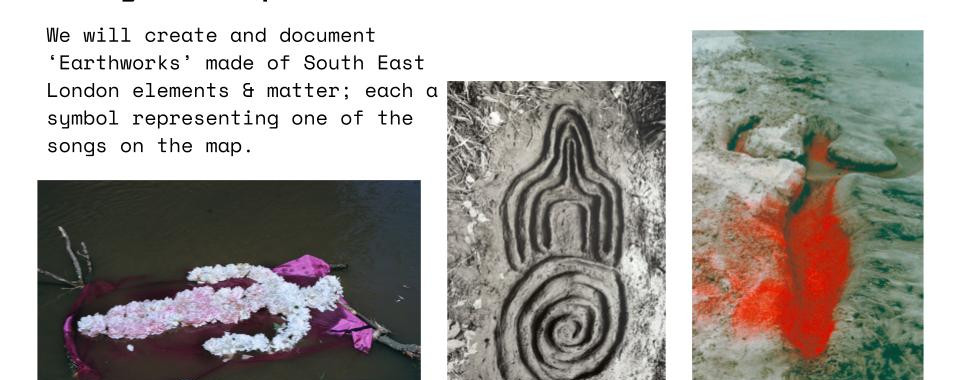









































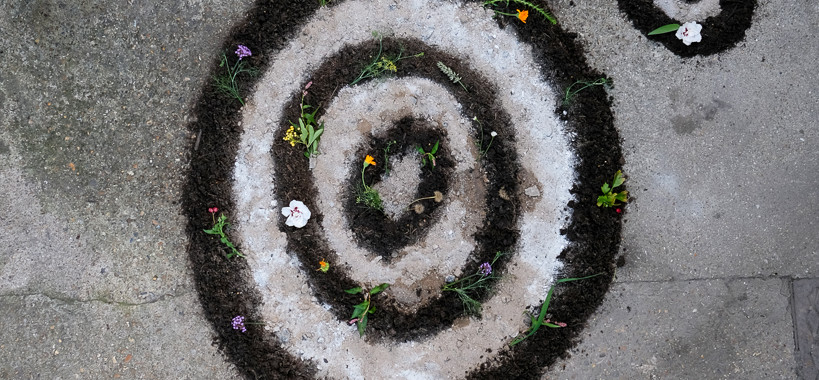







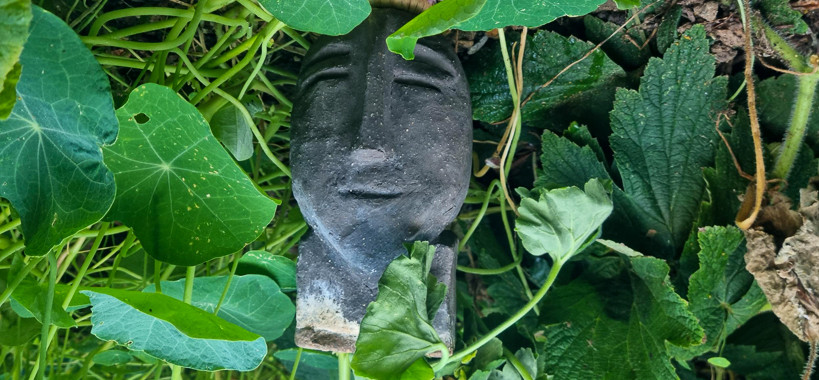





























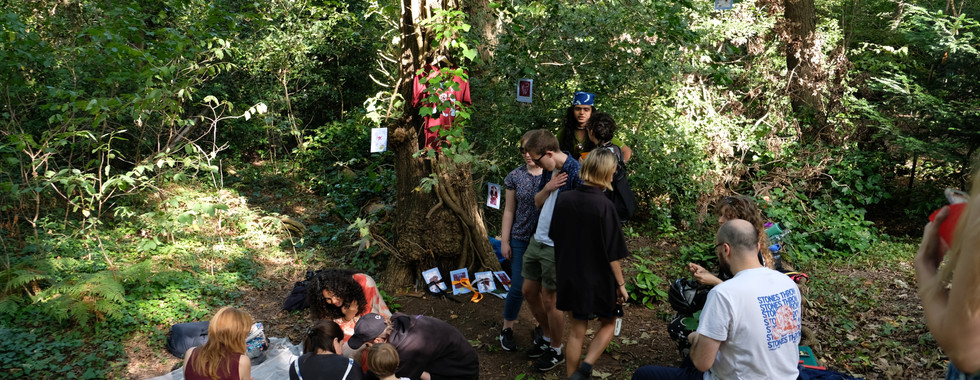
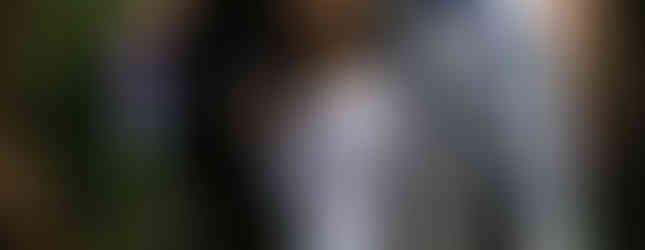





































































Comments